- State Board
-
12th Standard
-

Biology
-

Computer Applications
-

Computer Science
-

Business Maths and Statistics
-

Commerce
-

Economics
-

Maths
-

Chemistry
-

Physics
-

Computer Technology
-

History
-

Accountancy
-

Tamil
-

Maths
-

Chemistry
-

Physics
-

Biology
-

Computer Science
-

Business Maths and Statistics
-

Economics
-

Commerce
-

Accountancy
-

History
-

Computer Applications
-

Computer Technology
-

English
12th Standard stateboard question papers & Study material
தமிழ் Subjects
English Subjects
-
-
11th Standard
-

Maths
-

Biology
-

உயிரியல் - தாவரவியல்
-

Economics
-

Physics
-

Chemistry
-

History
-

Business Maths and Statistics
-

Computer Science
-

Accountancy
-

Commerce
-

Computer Applications
-

Computer Technology
-

Tamil
-

Maths
-

Commerce
-

Economics
-

Biology
-

Business Maths and Statistics
-

Accountancy
-

Computer Science
-

Physics
-

Chemistry
-

Computer Applications
-

History
-

Computer Technology
-

Tamil
-

English
11th Standard stateboard question papers & Study material
தமிழ் Subjects
English Subjects
-
-
9th Standard
-

-

-

-

-

-

-

Maths
-

Science
-

Social Science
-

Maths
-

Science
-

Social Science
9th Standard stateboard question papers & Study material
தமிழ் Subjects
English Subjects
-
-
6th Standard
-

Maths
-

Science
-

Social Science
-

Maths
-

Science
-

Social Science
6th Standard stateboard question papers & Study material
தமிழ் Subjects
English Subjects
-
-
10th Standard
-

Maths
-

Science
-

Social Science
-

Tamil
-

Maths
-

Science
-

Social Science
-

English
-

English
10th Standard stateboard question papers & Study material
தமிழ் Subjects
English Subjects
-
-
7th Standard
-

Maths
-

Science
-

Maths
-

Science
-

Social Science
7th Standard stateboard question papers & Study material
தமிழ் Subjects
English Subjects
-
-
8th Standard
-

கணிதம் - old
-

Science
-

Social Science
-

கணிதம்
-

Maths
-

Science
-

Social Science
8th Standard stateboard question papers & Study material
தமிழ் Subjects
English Subjects
-
-
12th Standard
- CBSE Board
-
12th Standard CBSE
-

Biology
-

Physics
-

Chemistry
-

Maths
-

Accountancy
-

Introductory Micro and Macroeconomics
-

Business Studies
-

Economics
-

Computer Science
-

Geography
-

English
-

History
-

Indian Society
-

Physical Education
-

Sociology
-

Tamil
-

Bio Technology
-

Engineering Graphics
-

Entrepreneurship
-

Hindi Core
-

Hindi Elective
-

Home Science
-

Legal Studies
-

Political Science
-

Psychology
12th Standard CBSE Subject Question Paper & Study Material
-
-
11th Standard CBSE
-

Mathematics
-

Chemistry
-

Biology
-

Physics
-

Business Studies
-

Accountancy
-

Economics
-

Computer Science
-

Bio Technology
-

English
-

Enterprenership
-

Geography
-

Hindi
-

History
-

Home Science
-

Physical Education
-

Political Science
-

Psychology
-

Sociology
-

Applied Mathematics
11th Standard CBSE Subject Question Paper & Study Material
-
- 10th Standard CBSE
-
9th Standard CBSE
-

Mathematics
-

Social Science
-

Science
-

English
-

Hindi
9th Standard CBSE Subject Question Paper & Study Material
-
-
8th Standard CBSE
-

Science
-

Social Science
-

Mathematics
-

English
8th Standard CBSE Subject Question Paper & Study Material
-
-
7th Standard CBSE
-

Mathematics
-

Science
-

Social Science
-

English
7th Standard CBSE Subject Question Paper & Study Material
-
-
6th Standard CBSE
-

Mathematics
-

Science
-

Social Science
-

English
6th Standard CBSE Subject Question Paper & Study Material
-
-
12th Standard CBSE
- Free Online Test
- News
- Study Materials
-
Students
-

Stateboard Tamil Nadu
-

CBSE Board
-

Free Online Tests
-

Educational News
-

Scholarships
-

Entrance Exams India
-

Video Materials
Study Materials , News and Scholarships
-
-
Students

12th Standard Physics English Medium Electrostatics Important Questions Question Bank Software Apr-23 , 2021
12th Standard Physics English Medium Electrostatics Important Questions
Electrostatics Important Questions
12th Standard
-
Reg.No. :
Physics
PART -A
Time :
03:00:00 Hrs
Total Marks :
100
-
Two identical point charges of magnitude –q are fixed as shown in the figure below. A third charge +q is placed midway between the two charges at the point P. Suppose this charge +q is displaced a small distance from the point P in the directions indicated by the arrows, in which direction(s) will +q be stable with respect to the displacement?
(a)A1 and A2
(b)B1 and B2
(c)both directions
(d)No stable
-
Two identical conducting balls having positive charges q1 and q2 are separated by a centre to centre distance r. If they are made to touch each other and then separated to the same distance, the force between them will be _____.
(a)less than before
(b)same as before
(c)more than before
(d)zero
-
An electric field \(\vec { E } =10x\hat { i } \) exists in a certain region of space. Then the potential difference V = Vo – VA, where Vo is the potential at the origin and VA is the potential at x = 2 m is _____.
(a)10 V
(b)-20 V
(c)+20 V
(d)-10 V
-
Three capacitors are connected in triangle as shown in the figure. The equivalent capacitance between the points A and C is
(a)1μF
(b)2μF
(c)3μF
(d)\(\frac{1}{4}\)μF
-
The electrostatic force obeys _______.
(a)Newton's I law
(b)Newton's II law
(c)Newton's III law
(d)none of the above
-
The value of constant 'K' in coulomb law is _____________.
(a)0.9 x 109 Nm2 C2
(b)9 x 10-9 Nm2C2
(c)9 x 109 Nm-2 C-2
(d)9 x 109 Nm2 C-2
-
The figure shows tow parallel equipotential surface A and B kept at a small distance 'r' a part from each other. A point change of Q coulomb is taken from the surface A to B. The amount of net work done will be
(a)\(W=\frac { -1 }{ 4\pi { \varepsilon }_{ 0 }r } \frac { q }{ r } \)
(b)\(W=\frac { 1 }{ 4\pi { \varepsilon }_{ 0 }r } \frac { q }{ r } \)
(c)\(W=\frac { -1 }{ 4\pi { \varepsilon }_{ 0 }r } \frac { q }{ r^2 } \)
(d)zero
-
An isolated metal sphere of radius 'r' is given a charge' q'. The potential energy of the sphere is ____________
(a)\(\frac { { q }^{ 2 } }{ 4\pi { \varepsilon }_{ 0 }r } \)
(b)\(\frac { { q }^{ } }{ 4\pi { \varepsilon }_{ 0 }r } \)
(c)\(\frac { { q }^{ } }{ 8\pi { \varepsilon }_{ 0 }r } \)
(d)\(\frac { { q }^{ 2 } }{ 8\pi { \varepsilon }_{ 0 }r } \)
-
Which one of these is a vector quantity?
(a)Electric charge
(b)Electric field
(c)Electric flux
(d)Electric potential
-
A positively charged body 'A' has been brought near a brass cylinder 'B' mounted on a glass stand as shown in the figure. The potential of 'B' will be
(a)zero
(b)Negative
(c)positive
(d)Infinite
-
The dipole is called point dipole when the distance ______________
(a)2a approaches infinity and q approaches zero
(b)2a approaches zero and q approaches infinity
(c)2a approaches zero and q approaches zero
(d)2a approaches infinity and q approaches infinity
-
In the given cricuit the effective capacitance between A and B will be
(a)3μf
(b)\(\frac{36}{13}\) μf
(c)13μf
(d)7μf
-
The capacitance of a parallel plate capacitor increases from 5μf of 50μf when a dielectric is filled between the plates. The permitivity of the dielectric is
(a)8.854 x 10-12 C2N-1 m-2
(b)8.854 x 10-11C2N-1 m-2
(c)10 x 10-12C2N-1 m-2
(d)12 x 10-12C2N-1 m-2
-
An electric dipole placed at an angle in a nonuniform electric field experiences
(a)neither a force nor a torque
(b)torque
(c)both force and torque
(d)force only
-
Which of the following statement on equipotential surface is wrong?
(a)The potential difference between any two points on the surface, is zero.
(b)The electric field is always perpendicular to the surface
(c)Equipotential surface is always spherical.
(d)No work is done in moving a charge along the surface
-
Region around a charge q in which it exerts force on a test charge is called
(a)electric flux intensity
(b)electric force
(c)electric field
(d)Coulomb's force
-
An electron moves in a straight line inside a charged parallel plate capacitor of uniform charge density σ. The time taken by the electron to cross the parallel plate capacitor undeflected when the plates of the capacitor are kept under constant magnetic field of induction \((\vec{B})\) is
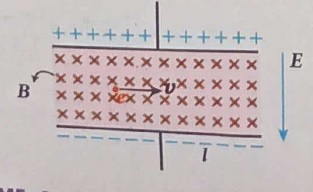 (a)
(a)\({ \varepsilon }_{ ° }\frac { elB }{ \sigma } \)
(b)\({ \varepsilon }_{ ° }\frac { lB }{ \sigma {l} } \)
(c)\({ \varepsilon }_{ ° }\frac { lB }{ {e}\sigma } \)
(d)\({ \varepsilon }_{ ° }\frac { lB }{ \sigma } \)
-
A thin insulated wire forms a plane spiral of N = 100 tight turns carrying a current I = 8 m A (milli ampere). The radii of inside and outside turns are a = 50 mm and b = 100 mm respectively. The magnetic induction at the centre of the spiral is ______.
(a)\(5\mu T\)
(b)\(7\mu T\)
(c)\(8\mu T\)
(d)\(10\mu T\)
-
A wire of length l carrying a current I along the Y direction is kept in a magnetic field is given by \(\vec { B } =\frac { \beta }{ \sqrt { 3 } } =(\hat { i } +\hat { j } +\hat { k } )T.\) The magnitude of Lorentz force acting on the wire is _____.
(a)\(\sqrt { \frac { 2 }{ { 3 } } } \beta Il\)
(b)\(\sqrt { \frac { 1 }{ { 3 } } } \beta Il\)
(c)\(\sqrt { 2 } \beta Il\)
(d)\(\sqrt { \frac { 1 }{ 2 } } \beta Il\)
-
The BH curve for a ferromagnetic material is shown in the figure. The material is placed inside a long solenoid which contains 1000 turns/cm. The current that should be passed in the solenoid to demagnetize the ferromagnet completely is _____.
(a)1.00 m A
(b)1.25 mA
(c)1.50 mA
(d)1.75 mA
-
Four wires each of length 2m are bent into four loops P, Q, R, and S, and then suspended into a uniform magnetic field as shown in the figure same current is passed in each loop. On which loop the couple will be the highest?
 (a)
(a)P
(b)Q
(c)R
(d)S
-
Which one of the following represents current magnetic field lines?
(a) (b)
(b) (c)
(c) (d)
(d)
-
The most suitable metal for permanent magnet is ______________.
(a)copper
(b)aluminium
(c)steel
(d)iron
-
When current is doubled deflection is also doubled in ______________.
(a)moving coil galvanometer
(b)tangent galvanometer
(c)both of them
(d)neither of two
-
An electron of mass 0.90 x 10-30kg under the action of a magnetic field moves in a circle of 2cm radius at a speed of 3 x 106 m/s if a proton of mass 1.8 x 10-27 kg was to move in a circle of the same radius in the same magnetic field, then its speed will be _______________.
(a)3.0 x 106 m/s
(b)1.5 x 103 m/s
(c)6.0 x 104 m/s
(d)cannot be estimated from the same data
-
Assertion: Kirchoff's voltage rule can be expressed as \({ \varepsilon }_{ 1 }+{ \varepsilon }_{ 2 }+{ \varepsilon }_{ 3 }+...{ \varepsilon }_{ n }={ I }_{ 1 }{ R }_{ 1 }+{ I }_{ 2 }{ R }_{ 2 }+...{ I }_{ n }{ R }_{ n }\)
Reason: For the given diagrams
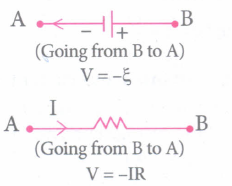
Codes:
(a) Assertion and Reason are correct and Reason is the correct explanation of Assertion.
(b) Assertion and Reason are true but Reason is the false explanation of the Assertion.
(c) Assertion is true but Reason is False.
(d) Assertion is false but Reason is True -
Assertion : A galvanometer can be converted into a voltmeter by connecting hight resistance (Rh) in series with the galvanometer.
Reason : The high resistance, Rh = \(\frac { V }{ { I }_{ g } } \)-Rg
Codes:
where, Ig ⟶ current through galvanometer
Rg ⟶ Resistance of the galvanometer
(a) Assertion and Reason are correct and Reason is the correct explanation of Assertion.
(b) Assertion and Reason are true but Reason is the false explanation of the Assertion.
(c) Assertion is true but Reason is false.
(d) Assertion is false but Reason is true. -
Assertion: If two ends of a solenoid are bent and together to form a closed ring shape, it is called as toroid
Reason: Magnetic field due to a long current-carrying solenoid is m
B=\(\frac { \mu NI }{ L } \) =μnI (where, n=\(\frac { N }{ L } \))
Codes:
(a) Assertion and Reason are correct and Reason is the correct explanation of Assertion.
(b) Assertion and Reason are true but Reason is the false explanation of the Assertion.
(c) Assertion is true but Reason is false.
(d) Assertion is false but Reason is true -
(a) Electric dipole moment
(b) Electric field intensity
(c) Electric potential difference
(d) Electrostatic shielding -
Find the odd one out.
(a) Electric current
(b) Pole strength
(c) Magnetic flux
(d) Magnetic dipole moment -
Find the odd one out.
(a) MRI scan
(b) head phones
(c) Hard disc of laptop
(d) Capacitor -
a) Franklin - +ve, -ve charges b) Gauss - electrical battery c) Van de graaff - high potential d) Faraday - Unit of capacitance -
a. Kirchhoff's I law - conservation of energy b. Ohm's law - resistance c. Kirchhoff's IIlaw - voltage law d. Joule's law heating effect current Which one is incorrect pair?
-
Which one is incorrect pair?
(a) Magnetic sensing of birds - Cryptochromes protein (Cry4) (b) Aurora borealis - Southern hemisphere (c) Pole strength - newton per tesla (d) Super conductors - diamagnetic materials -
When does a dielectric said to be polarized?
-
State macroscopic form of Ohm’s law.
-
Why are household appliances connected in parallel?
-
What is meant by hysteresis?
-
State the elements of Earth's magnetic field.
-
Consider the charge configuration as shown in the figure. Calculate the electric field at point A. If an electron is placed at points A, what is the acceleration experienced by this electron? (mass of the electron = 9.1 x 10-31 kg and charge of electron = −1.6 x 10-19 C)
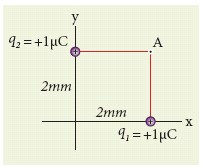
-
The following pictures depict electric field lines for various charge configurations.
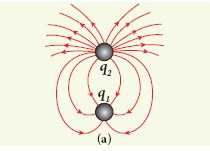
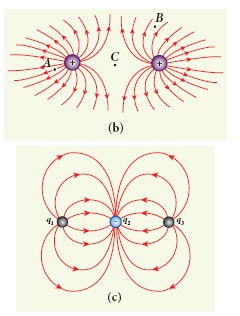
(i) In figure (a) identify the signs of two charges and find the ratio \(\left| \frac { { q }_{ 1 } }{ { q }_{ 2 } } \right| \)
(ii) In figure (b), calculate the ratio of two positive charges and identify the strength of the electric field at three points A, B, and C
(iii) Figure (c) represents the electric field lines for three charges. If q2 = -20 nC, then calculate the values of q1 and q3. -
Obtain the expression for energy stored in the parallel plate capacitor.
-
Explain the Lightning arrester or lightning conductor.
-
Define and derive an expression for the energy density in parallel plate capacitor.
-
If the resistance of coil is 3 Ω at 20oC and α = 0.004/oC then determine its resistance at 100oC.
-
Derive an expression of drift velocity and write the relation between drift velocity and mobility.
-
A coil of a tangent galvanometer of diameter 0.24 m has 100 turns. If the horizontal component of Earth’s magnetic field is 25 x 10–6 T then, calculate the current which gives a deflection of 60o .
-
Consider a point charge +q placed at the origin and another point charge -2q placed at a distance of 9 m from the charge +q. Determine the point between the two charges at which electric potential is zero.
-
A parallel plate capacitor filled with mica having εr = 5 is connected to a 10 V battery. The area of the parallel plate is 6 cm2 and separation distance is 6 mm.
(a) Find the capacitance and stored charge.
(b) After the capacitor is fully charged, the battery is disconnected and the dielectric is removed carefully.
Calculate the new values of capacitance, stored energy and charge. -
Draw the free body diagram for the following charges as shown in the figure (a), (b) and (c).
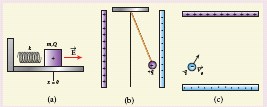
-
What charge would be required to electrify a sphere of radius 25 cm. So as to get a surface charge density of \(\frac{3}{\pi}\) cm-1?
-
The radius of gold nucleus (Z = 79) is about 7 x 10-15 m. Assume that the positive charge is distributed uniformly throughout the nuclear volume. Find the volume charge density.
-
The following graphs represent the current versus voltage and voltage versus current for the six conductors A, B, C, D, E, and F. Which conductor has least resistance and which has maximum resistance?
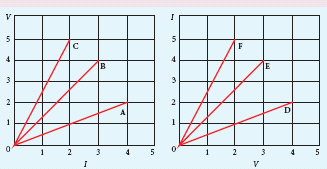
-
Calculate the effect internal resistance in series and parallel.
-
Show that for a straight conductor, the magnetic field
\(\overset { \rightarrow }{ B } =\frac { { \mu }_{ ° }I }{ 4\pi a } (cos\varphi _{ 1 }-cos\varphi _{ 2 })\hat { n } \)
\(=\frac { { \mu }_{ ° }I }{ 4\pi a } (sin{ \theta }_{ 1 }+sin{ \theta }_{ 2 })\hat { n } \) -
Drive an expression of Potential energy of a bar magnet in a uniform magnetic field.
( Multiple Choice Question )
25 x 1 = 25
PART -B
3 x 2 = 6
PART - C
3 x 2 = 6
PART - D
3 x 2 = 6
PART - E
6 x 2 = 12
PART - F
7 x 3 = 21
PART - G
5 x 5 = 25






 12th Standard Physics Syllabus
12th Standard Physics Syllabus  12th Standard Physics Study Materials
12th Standard Physics Study Materials 12th Standard Physics MCQ Practise Tests
12th Standard Physics MCQ Practise Tests 

Reviews & Comments about 12th Standard Physics English Medium Electrostatics Important Questions
Write your Comment